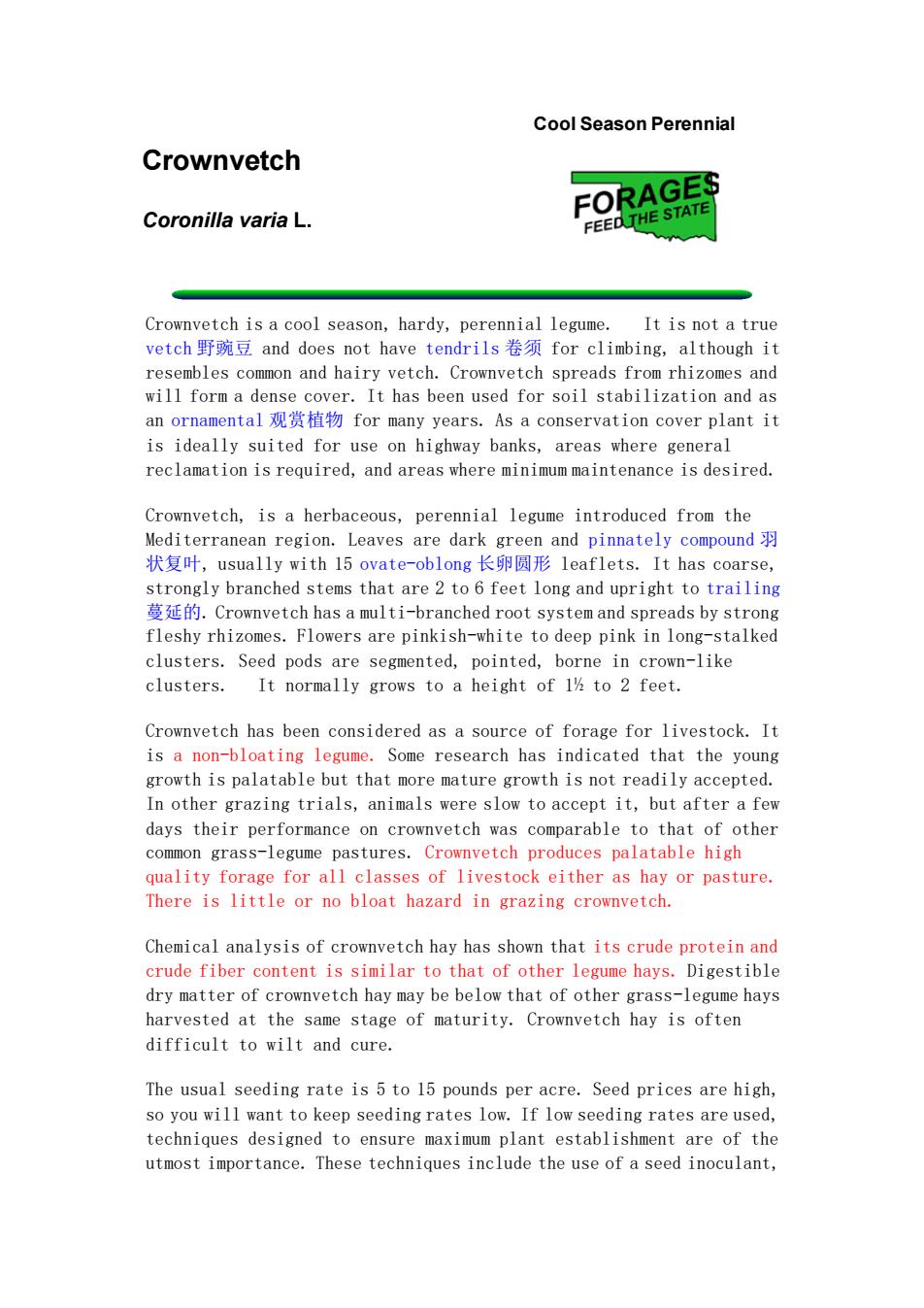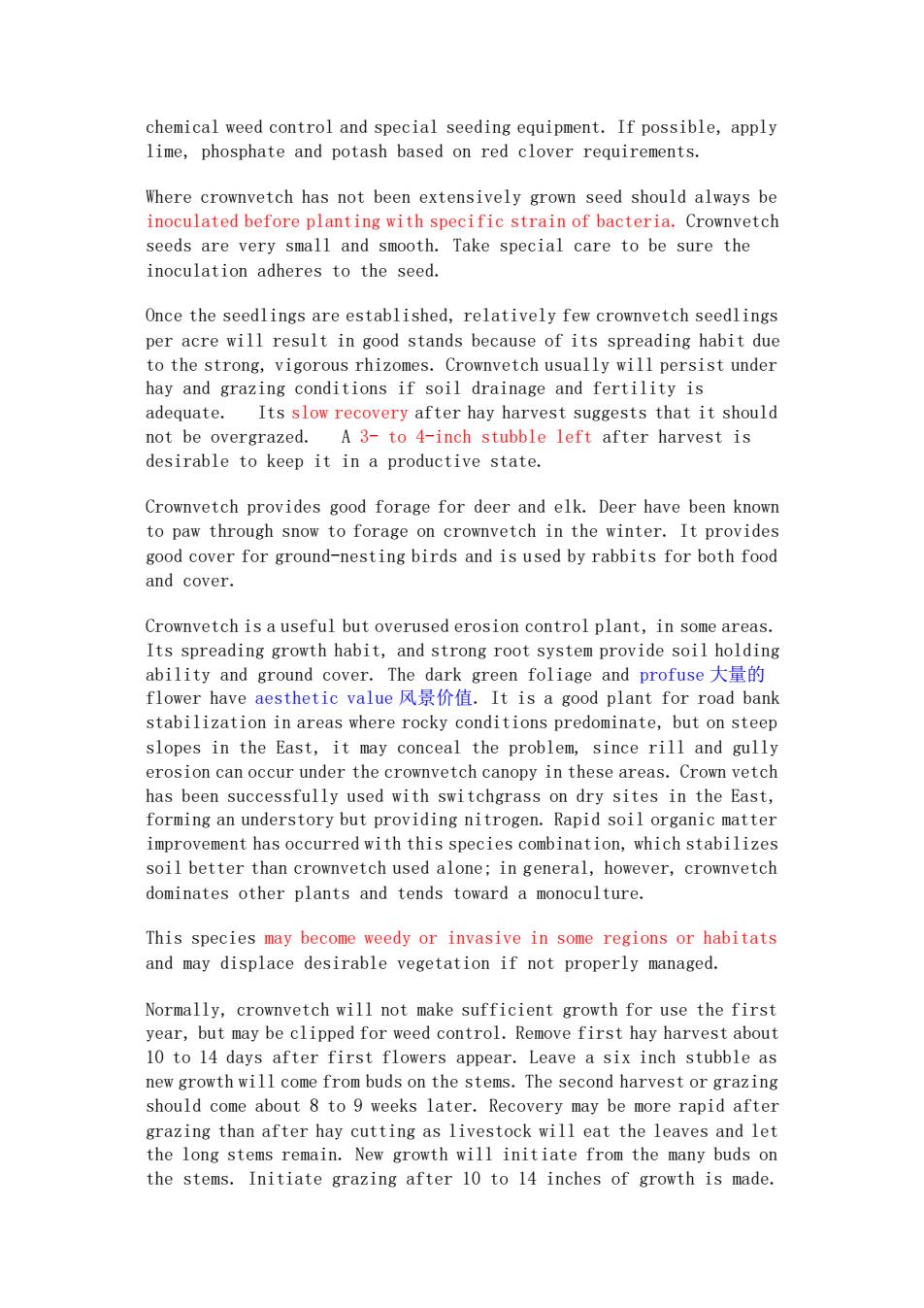
Cool Season Perennial Crownvetch FORAGES Coronilla varia L EED THE STATE Crownvetch is a cool season,hardy,perennial legume It is not a true vetch野豌豆and does not have tendri1s卷须for climbing,although it resembles common and hairy vetch.Crownvetch spreads from rhizomes and will form a dense cover.it has been used for soil stabilization and as an ornam ntal观赏植物for many years. As a conservation cover plant it is ideally suited for use on highway banks,areas where general reclamation is required,and areas where minimum maintenance is desired. Crownvetch,is a herbaceous,perennial legume introduced from the Mediterranean region. Leaves are dark green and pinnately compound 状复叶,usually with 15 ovate--oblong长卵圆形leaflets.It has coarse, strongly branched stems that are 2 to 6 feet long and upright to trailing Crownvetch has a multi-branched root system and spreads bys fleshy rhizomes. Flowers are pinkish-white to deep pink in clusters.Seed pods are segmented,pointed,borne in crown-like clusters.It normally grows to a height of 12 to 2 feet. Crownvetch has been considered as a source of forage for livestock.It is a non-bl oating legume.Some research has indicated that t the young growth is palatable but that more mature growth is not readily accepted. In other grazing trials,animals were slow to accept it,but after a few days their performance on crownvetch was comparable to that of other common grass-legume pastures.Crownvetch produces palatable high quality forage for all classes of livestock either as hay or pasture. There is little or no bloat hazard in grazing crownvetch. Chemical analysis of crownvetch hay has shown that its crude protein and crude fiber content is similar to that of other legume hays.Digestible dry matter of crownvetch hay may be below that of other grass-legume hays harvested at the same stage of maturity.Crownvetch hay is often difficult to wilt and cure. The usual seeding rate is 5 to 15 pounds per acre.Seed prices are high so you will want to keep seeding rates low.If low seeding rates are used, techniques designed to ensure maximum plant establishment are of the utmost importance.These techniques include the use of a seed inoculant
Crownvetch Coronilla varia L. Cool Season Perennial Crownvetch is a cool season, hardy, perennial legume. It is not a true vetch 野豌豆 and does not have tendrils 卷须 for climbing, although it resembles common and hairy vetch. Crownvetch spreads from rhizomes and will form a dense cover. It has been used for soil stabilization and as an ornamental 观赏植物 for many years. As a conservation cover plant it is ideally suited for use on highway banks, areas where general reclamation is required, and areas where minimum maintenance is desired. Crownvetch, is a herbaceous, perennial legume introduced from the Mediterranean region. Leaves are dark green and pinnately compound 羽 状复叶, usually with 15 ovate-oblong 长卵圆形 leaflets. It has coarse, strongly branched stems that are 2 to 6 feet long and upright to trailing 蔓延的. Crownvetch has a multi-branched root system and spreads by strong fleshy rhizomes. Flowers are pinkish-white to deep pink in long-stalked clusters. Seed pods are segmented, pointed, borne in crown-like clusters. It normally grows to a height of 1½ to 2 feet. Crownvetch has been considered as a source of forage for livestock. It is a non-bloating legume. Some research has indicated that the young growth is palatable but that more mature growth is not readily accepted. In other grazing trials, animals were slow to accept it, but after a few days their performance on crownvetch was comparable to that of other common grass-legume pastures. Crownvetch produces palatable high quality forage for all classes of livestock either as hay or pasture. There is little or no bloat hazard in grazing crownvetch. Chemical analysis of crownvetch hay has shown that its crude protein and crude fiber content is similar to that of other legume hays. Digestible dry matter of crownvetch hay may be below that of other grass-legume hays harvested at the same stage of maturity. Crownvetch hay is often difficult to wilt and cure. The usual seeding rate is 5 to 15 pounds per acre. Seed prices are high, so you will want to keep seeding rates low. If low seeding rates are used, techniques designed to ensure maximum plant establishment are of the utmost importance. These techniques include the use of a seed inoculant

chemical weed control and special seeding equipment.If possible,apply lime,phosphate and potash based on red clover requirements. Where crownvetch has not been extensively grown seed should always be inoculated before planting with specific strain of bacteria.Crownvetch seeds are very small and smooth.Take special care to be sure the inoculation adheres to the seed. Once the seedlings are established,relatively few crownvetch seedlings in good stands because of its spreading habit du to the strong,vigorous rhizomes.Crownvetch usually will persist under hay and grazing conditions if soil drainage and fertility is adequate.Its slow recovery after hay harvest suggests that it should not be overgrazed.A 3-to 4-inch stubble left after harvest is desirable to keep it in a productive state Crownvetch provides good forage for deer and elk.Deer have been known to paw through snow to forage on crownvetch in the winter.It provides good cover for ground-nesting birds and is used by rabbits for both food and cover. Crownvetch is a useful but over rosion control plant,in some areas. lding ability and ground cover.The dark green foliage and profuse大量的 flower have aesthetic value风景价值.It is a good plant for road bank stabilization in areas where rocky conditions predominate,but on steep slopes in the East,it may conceal the problem,since rill and gully erosion can occur under the anopy in these areas.Cr etch has been succ essfully used with switchgrass on dr ry si tes in the East forming an understory but providing nitrogen.Rapid soil organic matter improvement has occurred with this species combination,which stabilizes soil better than crownvetch used alone:in general,however,crownvetch dominates other plants and tends toward a monoculture. This species may bec come weedy or invasive in some regions or habitats and may displace desirable vegetation if not properly managed. Normally,crownvetch will not make sufficient growth for use the first year,but may be clipped for weed control.Remove first hay harvest about 10 to 14 days after first flowers appear.leave a six inch stubble as new growth will come from buds on the s ms.The second harvest or grazing should come about 8to9weeks later.Recovery may be more rapid after grazing than after hay cutting as livestock will eat the leaves and let the long stems remain.New growth will initiate from the many buds on the stems.Initiate grazing after 10 to 14 inches of growth is made
chemical weed control and special seeding equipment. If possible, apply lime, phosphate and potash based on red clover requirements. Where crownvetch has not been extensively grown seed should always be inoculated before planting with specific strain of bacteria. Crownvetch seeds are very small and smooth. Take special care to be sure the inoculation adheres to the seed. Once the seedlings are established, relatively few crownvetch seedlings per acre will result in good stands because of its spreading habit due to the strong, vigorous rhizomes. Crownvetch usually will persist under hay and grazing conditions if soil drainage and fertility is adequate. Its slow recovery after hay harvest suggests that it should not be overgrazed. A 3- to 4-inch stubble left after harvest is desirable to keep it in a productive state. Crownvetch provides good forage for deer and elk. Deer have been known to paw through snow to forage on crownvetch in the winter. It provides good cover for ground-nesting birds and is used by rabbits for both food and cover. Crownvetch is a useful but overused erosion control plant, in some areas. Its spreading growth habit, and strong root system provide soil holding ability and ground cover. The dark green foliage and profuse 大量的 flower have aesthetic value 风景价值. It is a good plant for road bank stabilization in areas where rocky conditions predominate, but on steep slopes in the East, it may conceal the problem, since rill and gully erosion can occur under the crownvetch canopy in these areas. Crown vetch has been successfully used with switchgrass on dry sites in the East, forming an understory but providing nitrogen. Rapid soil organic matter improvement has occurred with this species combination, which stabilizes soil better than crownvetch used alone; in general, however, crownvetch dominates other plants and tends toward a monoculture. This species may become weedy or invasive in some regions or habitats and may displace desirable vegetation if not properly managed. Normally, crownvetch will not make sufficient growth for use the first year, but may be clipped for weed control. Remove first hay harvest about 10 to 14 days after first flowers appear. Leave a six inch stubble as new growth will come from buds on the stems. The second harvest or grazing should come about 8 to 9 weeks later. Recovery may be more rapid after grazing than after hay cutting as livestock will eat the leaves and let the long stems remain. New growth will initiate from the many buds on the stems. Initiate grazing after 10 to 14 inches of growth is made

cromvetch is a little ore palatable than most other legmes. therefore it can be stockpiled to take advantage of other forages. IMAGES Flowers Leaves Plant Back to Forage Contents OSU OEXTENSION SERVICE Previous Page
Mature crownvetch is a little more palatable than most other legumes, therefore it can be stockpiled to take advantage of other forages. IMAGES Flowers Leaves Plant Back to Forage Contents Previous Page